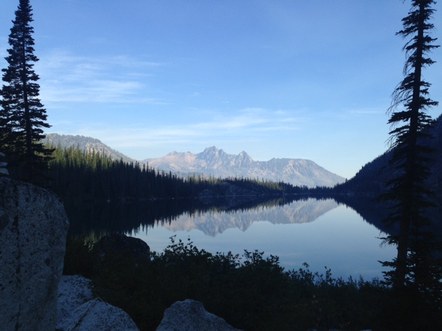Trail Running
Trail runs are on-trail activities in both semi-urban and backcountry areas, usually moving at a faster pace and with an emphasis on traveling light. They require a mix of skills for traveling across various types of terrain; anything from paved streets to forest service roads or single-track trails of dirt, sand, stone, snow, or another material.
Difficulty Ratings
Difficulty ratings for trail running routes use the following scale as a general guide. Leaders may set a route’s baseline difficulty rating to a higher difficulty level to reflect trail conditions or the need to use equipment such as traction devices.
- Easy - Up to 5 miles round trip with less than 1,000 feet of elevation gain or a moderate trip with an average pace of 3-4 mph or slower. Easy runs are not held in darkness and do not require equipment such as traction devices or poles.
- Moderate - Up to 10 miles round trip or with 2,000-3,000 feet of elevation gain or a strenuous trip with an average pace of 3-4 mph. Trail runs which would otherwise be categorized as Easy but that do require equipment such as traction devices or poles or that are held in darkness are listed as Moderate.
- Strenuous - Up to 15 miles round trip or with 3,000-4,500 feet of elevation gain or a very strenuous trip with an average pace of 3-4 mph. Equipment may be required, and the trail run may be held in darkness.
- Very Strenuous - 15-20 miles total or over 4,500 feet of elevation gain, or a shorter mileage/smaller elevation gain trip with an aggressive pace. Equipment may be required, and the trail run may be held in darkness.
- Ultra - 20-31 miles total which does not fall under Advanced Ultra 1 as described below. For all Ultra categories equipment may be required, and the trail run may be held in darkness.
- Advanced Ultra 1 - 20-31 miles total which will be covered at an aggressive pace, has an exceptional level of difficulty or remoteness, or requires significant technical skills and equipment.
- Advanced Ultra 2 - 32-50 miles total with has an exceptional level of difficulty or remoteness, requires significant technical skills and equipment, or will be covered at an aggressive pace. Or any trip 51 miles round trip or longer, even if held in a non-backcountry setting.
Leader Ratings
In addition to the route classification, a Leader Rating is specified for each activity. This provides the leader with a way to modify the baseline route difficulty based on specifics of how they will lead the trip. The following are examples of criteria a leader may consider in setting the Leader Rating.
- Casual - Average pace 3 mph or slower counting any rest breaks but not counting a lunch break or a planned pause for instruction and skills practice. No technical challenges are present and no equipment or special skills are needed. Run is not held in darkness.
- Easy - Average pace 3-4 mph and no technical challenges are present and no special skills are needed.
- Moderate - Average pace 3-4 mph or an easy route with a heavier pack due to logistical requirements, such as the need to carry extra water and supplies, or some route challenges (e.g. rough trail, log crossings, steep terrain, crossing a talus slope).
- Challenging - Average pace greater than 3 mph or a trail run rated as Moderate done with a heavier pack that the leader plans to lead in a challenging fashion, or significant route challenges or skills requirements (e.g. fixed ropes, very rugged terrain, steep scree descents, snow crossings; mandatory use of traction devices). Challenging applies to all routes rated as Strenuous, Very Strenuous, and Ultra. Challenging also applies to organized races/events where participants aim for maximum speed and must negotiate the trail with others participating in the same event.
Frontcountry Trail Routes
Frontcountry trail routes are established routes where the following conditions apply: cell phone reception is nearly continually available (access within 30 minutes of the runner’s location); the route is frequently used by others; exit points are easily reached; and help is easily summoned. Examples are city parks and state parks (e.g., Discovery Park, Bridle Trails state park, Redmond Watershed Preserve); urban and suburban trails (e.g., Issaquah-Preston Trail, Snoqualmie Valley Trail); the Issaquah Alps (e.g.,Tiger, Squak, and Cougar Mountains) and open spaces/greenbelts (e.g., Coal Creek Natural Area, Bellevue’s Lake-to-Lake Trail). There should not be significant off-trail travel as part of the route.
Anyone is welcome to sign-up for a frontcountry trail run. Gauge what you want from your running experience and select among the multiple types of runs posted throughout the region.
Backcountry Trail Routes
Backcountry trail routes are established routes in wilderness areas and other remote areas where the following conditions apply: help is not easily summoned; the terrain is rugged and difficult; the route may not be in frequent use by others; exit points are far apart or not easily reached; or in the leader’s judgment, the route does not qualify as a frontcountry route. Examples are national parks and designated wilderness areas (e.g., Alpine Lakes Wilderness, North Cascades National Park); long-distance trails which do not intersect with roads (e.g., Pacific Crest Trail Section J between Snoqualmie Pass and Stevens Pass); and primitive, unmaintained trails (e.g., the Enchantments traverse between the Lake Stuart trailhead and the Snow Lakes trailhead). There should not be significant off-trail travel as part of the route.
Because of the remoteness of the location and the distance trail runners can cover in a relatively short amount of time, additional skills are needed to run or lead runs on backcountry routes.
Volunteer As a trail run leader
Trail Run Leaders have been approved by their branch's Trail Running Committee to lead others on frontcountry or backcountry runs.
There are two Trail Run leader types. Please visit each leader badge page to learn more:
